Marvell公司和产品简绍-new
- 格式:pdf
- 大小:2.26 MB
- 文档页数:17
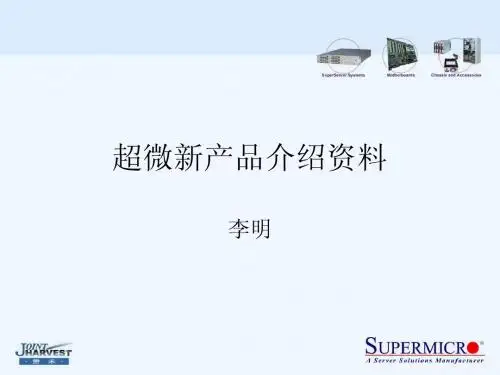
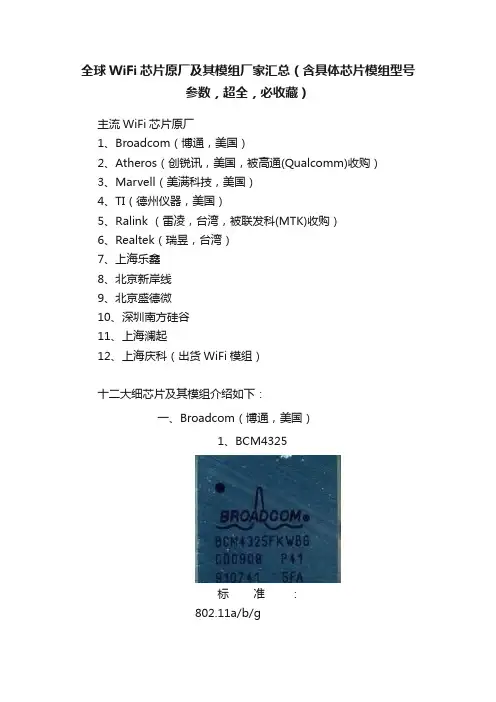
全球WiFi芯片原厂及其模组厂家汇总(含具体芯片模组型号参数,超全,必收藏)主流WiFi芯片原厂1、Broadcom(博通,美国)2、Atheros(创锐讯,美国,被高通(Qualcomm)收购)3、Marvell(美满科技,美国)4、TI(德州仪器,美国)5、Ralink (雷凌,台湾,被联发科(MTK)收购)6、Realtek(瑞昱,台湾)7、上海乐鑫8、北京新岸线9、北京盛德微10、深圳南方硅谷11、上海澜起12、上海庆科(出货WiFi模组)十二大细芯片及其模组介绍如下:一、Broadcom(博通,美国)1、BCM4325标准:802.11a/b/g频段:2.4/5GHz最大传输速率:150Mbps功能:WiFi+BT2.1+FM应用:游戏设备,笔记本电脑,便携式音频/媒体/游戏设备,打印机备注:iPhone4,HTC,LG,SAMSUNG手机上都用过此芯片做的模组如下:(1)村田模组LBEH198UNBC-TEMP2、BCM4329标准:802.802.11a/b/g/n频段:2.4GHz最大传输速率:300Mbps功能:WiFi+BT2.1+FM应用:便携式音频/多媒体/游戏设备此芯片做的模组如下:▼(1)、TDK模组QRF3001应用:手机、平板、OTT盒子等。
▼(2)、海华模组AW-NH6113、BCM4330标准:802.11a/b/g/n频段:2.4/5GHz最大传输速率:150Mbps功能:WiFi+BT4.0+FM应用:智能手机,平板电脑、网络播放器等备注:iphone4S用过此芯片做的模组如下:▼(1)USI环旭模组WM-BN-BM-04(2)USI 环旭模组WM-BAN-BM-04(3)USI 环旭模组WM-BAN-BM-06▼(4)正基模组AP6493▼(5)正基模组AP63304、BCM4390标准:802.11b/g/n此芯片做的模组如下:(1)村田模组LBWB1ZZ1AD(2)村田模组LBWA1CS1AD5、BCM4334标准:802.11b/g/n频段:2.4/5GHz最大传输速率:150Mbps功能:WiFi+BT4.0+FM应用:智能手机,平板电脑备注:iphone5用过,村田331S0171模块的核心芯片此芯片做的模组如下:(1)村田模组331S0171▼(2)USI模组WM-BAN-BM-07_S▼(3)正基模组AP6234▼(4)正基模组AP64746、BCM4335标准:802.11a/b/g/n/ac频段:2.4/5GHz最大传输速率:433.3Mbps功能:WiFi+BT4.0+FM应用:智能手机,平板电脑,网络播放器等备注:三星手机i9500,note3,19508,Galaxy S4,HTC One有使用此芯片做的模组如下:▼(1)村田模组LBEH5DPXJC-589(2)USI模组WM-BAC-BM-15▼(3)正基模组AP63357、BCM4336标准:802.11b/g/n频段:2.4/5GHz功能:单WiFi此芯片做的模组如下:(1)村田模组LBWA17DZX68、BCM4339标准:802.11a/b/g/n/ac频段:2.4/5GHz功能:WiFi+BT4.0应用:低端智能手机、平板或PC nubia Z5S使用过此芯片做的模组如下:(1)村田模组LBEH5HMZPC9、BCM4343W标准:802.11b/g/n此芯片做的模组如下:(1)村田模组LBEE5KL1DX10、BCM4383频段:2.4GHz此芯片做的模组如下:(1)正基模组AP638311、BCM40181标准:802.11 b/g/n频段:2.4GHz此芯片做的模组如下:▼(1)正基模组AP618112、BCM43340标准:802.11a/b/g/n频段:2.4/5GHz功能:WiFi+BT4.0此芯片做的模组如下:(1)村田模组LBEH5DU1BW13、BCM43241标准:802.11a/b/g/n频段:2.4/5GHz最大传输速率:300Mbps功能:WiFi+BT4.0+FM此芯片做的模组如下:▼(1)USI模组WM-BAN-BM-1014、BCM43341标准:802.11 g/n频段:2.4/5GHz最大传输速率:150Mbps功能:WiFi+BT4.0+NFC + FM此芯片做的模组如下:(1)正基模组AP644115、BCM43362+MCU标准:802.11b/g/n频段:2.4/5GHz功能:单WiFi此芯片做的模组如下:(1)88-00153-00(2)村田模组88-00153-02(3)村田模组88-0015(4)村田模组LBWA1ZVYDZ(5)村田模组LBWB1ZZYDZ-683(6)村田模组LBWA1ZVZDZ(7)村田模组LBWB1ZZYDZ-740(8)村田模组LBWA1ZV1CD▼(9)USI模组WM-N-BM-02▼(10)USI模组WM-N-BM-09▼(11)USI模组WM-N-BM-14▼(12)正基模组AP6476(BCM43362+BCM2076)▼(13)正基模组AP6210(WiFi BCM43362+蓝牙BCM20710)(14)正基模组AP6251(BCM 43362+BCM4751)16、BCM43364标准:802.11b/g/n此芯片做的模组如下:(1)村田模组LBWA1KL1FX17、BCM43438标准:802.11b/g/n此芯片做的模组如下:(1)村田模组LBWA1ZZ1HD18、BCM43907标准:802.11a/b/g/n此芯片做的模组如下:(1)村田模组LBWA1UZ1GC二、Atheros(创锐讯,美国,被高通(Qualcomm)收购)1、AR1021x标准:802.11a/b/g/n频段:2.4/5GHz最大传输速率:300 Mbps此芯片做的WiFi模组如下:▼(1)科中龙WM801应用:MID,网络摄像头,机顶盒GPS,电子书,硬盘播放器,网络收音机,PSP等需要实现无线联网设备的消费类电子产品。
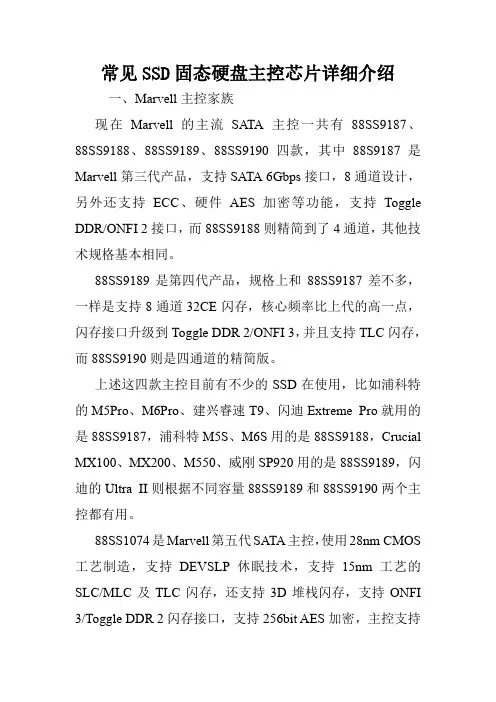
常见SSD固态硬盘主控芯片详细介绍一、Marvell主控家族现在Marvell的主流SATA主控一共有88SS9187、88SS9188、88SS9189、88SS9190四款,其中88S9187是Marvell第三代产品,支持SATA 6Gbps接口,8通道设计,另外还支持ECC、硬件AES加密等功能,支持Toggle DDR/ONFI 2接口,而88SS9188则精简到了4通道,其他技术规格基本相同。
88SS9189是第四代产品,规格上和88SS9187差不多,一样是支持8通道32CE闪存,核心频率比上代的高一点,闪存接口升级到Toggle DDR 2/ONFI 3,并且支持TLC闪存,而88SS9190则是四通道的精简版。
上述这四款主控目前有不少的SSD在使用,比如浦科特的M5Pro、M6Pro、建兴睿速T9、闪迪Extreme Pro就用的是88SS9187,浦科特M5S、M6S用的是88SS9188,Crucial MX100、MX200、M550、威刚SP920用的是88SS9189,闪迪的Ultra II则根据不同容量88SS9189和88SS9190两个主控都有用。
88SS1074是Marvell第五代SATA主控,使用28nm CMOS 工艺制造,支持DEVSLP休眠技术,支持15nm工艺的SLC/MLC及TLC闪存,还支持3D堆栈闪存,支持ONFI 3/Toggle DDR 2闪存接口,支持256bit AES加密,主控支持Marvell第三代的NANDEdge纠错及LDPC低密度奇偶校验技术,这对TLC闪存SSD尤为重要,用这款主控的主要有浦科特M7V、闪迪X400和金士顿UV400。
88NV1120是一款入门级主控,主打低价市场,采用ARM Cortex R5双核心架构,使用28nm工艺制作,内建Embedded SRAM来代替外部DRAM,支持ONFI 3.0与Toggle 2.0接口的NAND芯片,为了更好的支持15nm TLC与3D NAND而加入了最新的NANDEdge LDPC校验技术。
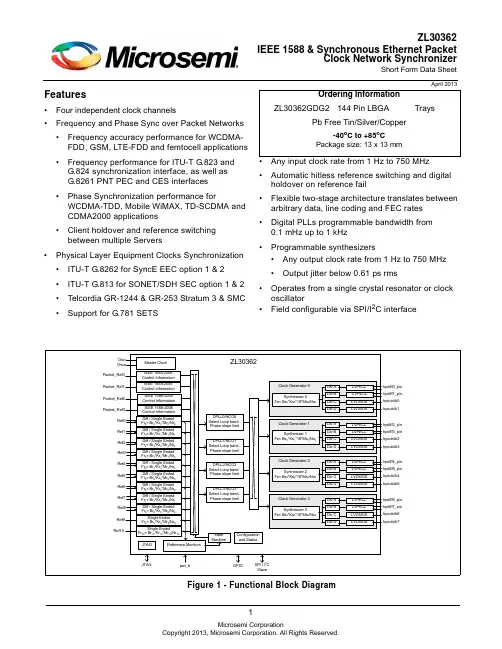
1Features•Four independent clock channels•Frequency and Phase Sync over Packet Networks •Frequency accuracy performance for WCDMA-FDD, GSM, LTE-FDD and femtocell applications •Frequency performance for ITU-T G.823 and G.824 synchronization interface, as well as G.8261 PNT PEC and CES interfaces•Phase Synchronization performance forWCDMA-TDD, Mobile WiMAX, TD-SCDMA and CDMA2000 applications•Client holdover and reference switching between multiple Servers•Physical Layer Equipment Clocks Synchronization •ITU-T G.8262 for SyncE EEC option 1 & 2•ITU-T G.813 for SONET/SDH SEC option 1 & 2•Telcordia GR-1244 & GR-253 Stratum 3 & SMC •Support for G.781 SETS•Any input clock rate from 1Hz to 750MHz •Automatic hitless reference switching and digital holdover on reference fail•Flexible two-stage architecture translates between arbitrary data, line coding and FEC rates •Digital PLLs programmable bandwidth from 0.1mHz up to 1kHz•Programmable synthesizers•Any output clock rate from 1 Hz to 750 MHz •Output jitter below 0.61 ps rms•Operates from a single crystal resonator or clock oscillator•Field configurable via SPI/I 2C interfaceApril 2013Figure 1 - Functional Block DiagramZL30362IEEE 1588 & Synchronous Ethernet PacketClock Network SynchronizerShort Form Data SheetOrdering InformationZL30362GDG2144 Pin LBGATraysPb Free Tin/Silver/Copper-40o C to +85o CPackage size: 13 x 13 mmDetailed FeaturesGeneral•Four independent clock channels•Operates from a single crystal resonator or clock oscillator•Configurable its SPI/I2C interfaceTime Synchronization Algorithm•External algorithm controls software digital PLL to adjust frequency & phase alignment•Frequency, Phase and Time Synchronization over IP, MPLS and Ethernet Packet Networks•Frequency accuracy performance for WCDMA-FDD, GSM, LTE-FDD and femtocell applications, with target performance less than ± 15 ppb.•Frequency performance for ITU-T G.823 and G.824 synchronization interface, as well as G.8261 PNT EEC, PNT PEC and CES interface specifications.•Phase Synchronization performance for WCDMA-TDD, Mobile WiMAX, TD-SCDMA and CDMA2000 applications with target performance less than ± 1 s phase alignment.•Time Synchronization for UTC-traceability and GPS replacement.•Client reference switching between multiple Servers•Client holdover when Server packet connectivity is lostElectrical Clock Inputs•Nine input references configurable as single ended or differential and two single ended input references •Synchronize to any clock rate from 1 Hz to 750 MHz on differential inputs•Synchronize to any clock rate from 1 Hz to 177.75 MHz on singled-ended inputs•Any input reference can be fed with sync (frame pulse) or clock.•Synchronize to sync pulse and sync pulse/clock pair.•Flexible input reference monitoring automatically disqualifies references based on frequency and phase irregularities•LOS•Single cycle monitor•Precise frequency monitor•Coarse frequency monitor•Guard soak timer•Per input clock delay compensationElectrical Clock Engine•Digital PLLs filter jitter from 0.1 mHz up to 1 kHz•Flexible two-stage architecture translates between arbitrary data rates, line coding rates and FEC rates •Internal state machine automatically controls mode of operation (free-run, locked, holdover)•Automatic hitless reference switching and digital holdover on reference fail•Physical-to-physical reference switching•Physical-to-packet reference switching•Packet-to-physical reference switching•Packet-to-packet reference switching•Support for wide variety of Equipment Clock specifications•SyncE•ITU-T G.8262 option 1 EEC (Europe/China)•ITU-T G.8262 option 2 (USA)•SONET/SDH•ITU-T G.813 option 1 SEC (Europe/China)•ITU-T G.813 option 2 (USA)•ANSI T1.105/Telcordia GR-253 Stratum 3 for SONET•Telcordia GR-253 SMC•PDH•ITU-T G.812 Type I SSU•ITU-T G.812 Type III, ANSI T1.101/Telcordia GR-1244 Stratum 3E, including phase build out•ANSI T1.101/Telcordia GR-1244 Stratum 3•ANSI T1.101/Telcordia GR-1244 Stratum 4E/4•Selectable phase slope limiting•Holdover better than 1 ppb (when using < 0.1 Hz filter)•Supports ITU-T G.823, G.824 and G.8261 for 2048kbit/s and 1544kbit/s interfaces•Supports G.781 SETSElectrical Clock Generation•Four programmable synthesizers•Eight LVPECL outputs•Two LVPECL outputs per synthesizer•Generate any clock rate from 1 Hz to 750 MHz•Maximum jitter below 0.61 ps RMS•Meets OC-192, STM-64, 1 GbE & 10 GbE interface jitter requirements•Eight LVCMOS outputs•Two LVCMOS outputs per synthesizer•Generate any clock rate from 1 Hz to 177.75 MHz•Maximum jitter below 1 ps rms•Programmable output advancement/delay to accommodate trace delays or compensate for system routing paths•Outputs may be disabled to save powerAPI Software•Interfaces to 1588-capable PHY and switches with integrated timestamping•Abstraction layer for independence from OS and CPU, from embedded SoC to home-grown•Fits into centralized, highly integrated pizza box architectures as well as distributed architectures with multiple line cards and timing cardsApplications•ITU-T G.8262 System Timing Cards which support 1GbE and 10GbE interfaces•Telcordia GR-253 Carrier Grade SONET/SDH Stratum 3 System Timing Cards•System Timing Cards which supports ITU-T G.781 SETS (SDH Equipment Timing Source)•Integrated basestation reference clock for air interface for GSM, WCDMA, LTE and WiMAX macro, micro or femtocells•Mobile Backhaul NID, edge router or access aggregation node•EPON/GE-PON & GPON OLT•EPON/GE-PON & GPON ONU/OLT•DSLAM and RT-DSLAM•10Gigabit line cards•Synchronous Ethernet, 10GBASE-R and 10GBASE-W•SONET/SDH, Fibre Channel, XAUIInformation relating to products and services furnished herein by Microsemi Corporation or its subsidiaries (collectively “Microsemi”) is believed to be reliable. However, Microsemi assumes no liability for errors that may appear in this publication, or for liability otherwise arising from the application or use of any suchinformation, product or service or for any infringement of patents or other intellectual property rights owned by third parties which may result from such application or use. Neither the supply of such information or purchase of product or service conveys any license, either express or implied, under patents or other intellectual property rights owned by Microsemi or licensed from third parties by Microsemi, whatsoever. Purchasers of products are also hereby notified that the use of product in certain ways or in combination with Microsemi, or non-Microsemi furnished goods or services may infringe patents or other intellectual property rights owned by Microsemi.This publication is issued to provide information only and (unless agreed by Microsemi in writing) may not be used, applied or reproduced for any purpose nor form part of any order or contract nor to be regarded as a representation relating to the products or services concerned. The products, their specifications, services and other information appearing in this publication are subject to change by Microsemi without notice. No warranty or guarantee express or implied is made regarding the capability, performance or suitability of any product or service. Information concerning possible methods of use is provided as a guide only and does not constitute any guarantee that such methods of use will be satisfactory in a specific piece of equipment. It is the user’s responsibility to fully determine the performance and suitability of any equipment using such information and to ensure that any publication or data used is up to date and has not been superseded.Manufacturing does not necessarily include testing of all functions or parameters. These products are not suitable for use in any medical and other products whose failure to perform may result in significant injury or death to the user. All products and materials are sold and services provided subject to Microsemi’s conditions of sale which are available on request.Purchase of Microsemi’s I 2C components conveys a license under the Philips I 2C Patent rights to use these components in an I 2C System, provided that the system conforms to the I 2C Standard Specification as defined by Philips.Microsemi, ZL, and combinations thereof, VoiceEdge, VoicePort, SLAC, ISLIC, ISLAC and VoicePath are trademarks of Microsemi Corporation.TECHNICAL DOCUMENTATION - NOT FOR RESALEFor more information about all Microsemi productsvisit our Web Site at/timing-and-synchronization。
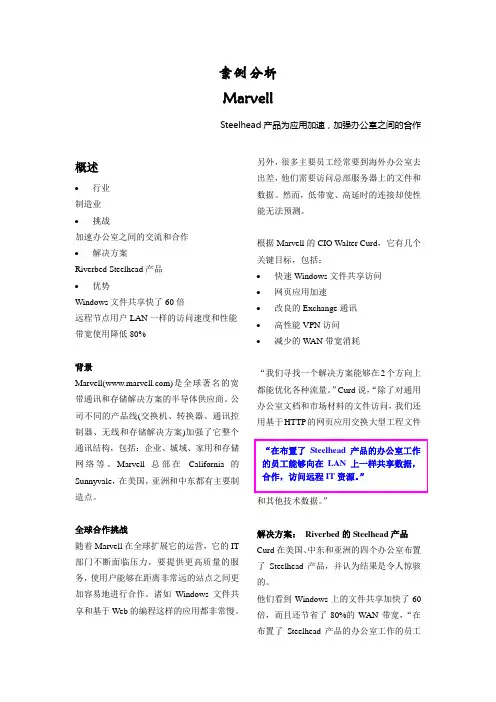
案例分析MarvellSteelhead产品为应用加速,加强办公室之间的合作概述∙行业制造业∙挑战加速办公室之间的交流和合作∙解决方案Riverbed Steelhead产品∙优势Windows文件共享快了60倍远程节点用户LAN一样的访问速度和性能带宽使用降低80%背景Marvell()是全球著名的宽带通讯和存储解决方案的半导体供应商。
公司不同的产品线(交换机、转换器、通讯控制器、无线和存储解决方案)加强了它整个通讯结构,包括:企业、城域、家用和存储网络等。
Marvell总部在California的Sunnyvale,在美国,亚洲和中东都有主要制造点。
全球合作挑战随着Marvell在全球扩展它的运营,它的IT 部门不断面临压力,要提供更高质量的服务,使用户能够在距离非常远的站点之间更加容易地进行合作。
诸如Windows文件共享和基于Web的编程这样的应用都非常慢。
另外,很多主要员工经常要到海外办公室去出差,他们需要访问总部服务器上的文件和数据。
然而,低带宽、高延时的连接却使性能无法预测。
根据Marvell的CIO Walter Curd,它有几个关键目标,包括:∙快速Windows文件共享访问∙网页应用加速∙改良的Exchange通讯∙高性能VPN访问∙减少的W AN带宽消耗“我们寻找一个解决方案能够在2个方向上都能优化各种流量。
”Curd说,“除了对通用办公室文档和市场材料的文件访问,我们还用基于HTTP的网页应用交换大型工程文件和其他技术数据。
”解决方案:Riverbed的Steelhead产品Curd在美国、中东和亚洲的四个办公室布置了Steelhead产品,并认为结果是令人惊骇的。
他们看到Windows上的文件共享加快了60倍,而且还节省了80%的WAN带宽,“在布置了Steelhead产品的办公室工作的员工能够向在LAN上一样共享数据,合作,访问远程IT资源。
”Curd说,“出差到远方办公室的员工能够通过Windows获得他自己办公室的共享文件,而且速度非常快,就像在他自己的办公室里一样。
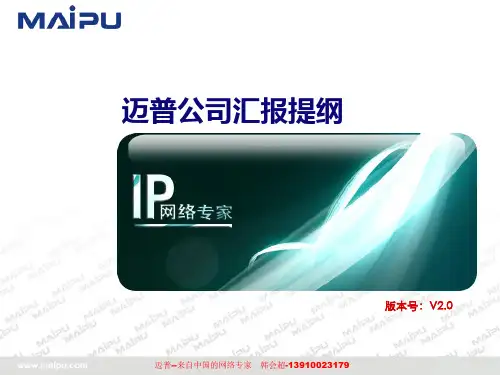
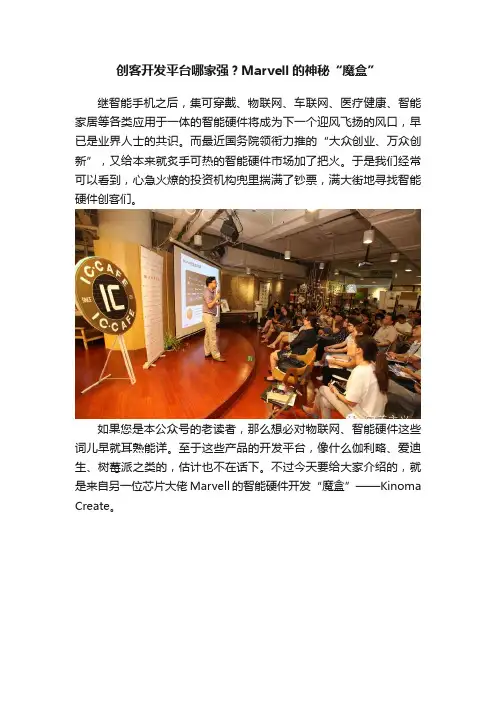
创客开发平台哪家强?Marvell的神秘“魔盒”继智能手机之后,集可穿戴、物联网、车联网、医疗健康、智能家居等各类应用于一体的智能硬件将成为下一个迎风飞扬的风口,早已是业界人士的共识。
而最近国务院领衔力推的“大众创业、万众创新”,又给本来就炙手可热的智能硬件市场加了把火。
于是我们经常可以看到,心急火燎的投资机构兜里揣满了钞票,满大街地寻找智能硬件创客们。
如果您是本公众号的老读者,那么想必对物联网、智能硬件这些词儿早就耳熟能详。
至于这些产品的开发平台,像什么伽利略、爱迪生、树莓派之类的,估计也不在话下。
不过今天要给大家介绍的,就是来自另一位芯片大佬Marvell的智能硬件开发“魔盒”——Kinoma Create。
6月18日,Marvell携手IC咖啡在中关村创业大街举办了“智能时代创客工作坊”,这是Marvell旗下的智能硬件开发平台Kinoma Create开源开发套件首次在中国登台亮相,同时也拉开了“美满最强创客挑战赛”的序幕。
就国内的创客文化而言,虽然其起步时间较欧美等发达国家要晚,但是随着近年来中国智能硬件创业氛围的火爆,国内的创客文化也愈发浓厚,并逐步形成了以北京、上海、深圳为三大中心的创客文化圈。
譬如最近登陆深圳的“Maker Faire”,就为国内的创客提供了一个与全球创客圈接轨的平台。
在这样的背景之下,Marvell将旗下整合了硬件、软件和工具的设备开发套件Kinoma Create首次带到中国,希望能够借此推动中国的创客运动普及和物联网智能硬件创新。
Marvell技术支持总监孟树表示,中国有大批优秀的创客,尤其是大学生创客。
他们充满青春正能量,思维活跃超前,许多创意都令人折服。
而由Marvell人力资源部发起的、Kinoma团队提供支持的“美满最强创客挑战赛”,其主旨正是为了鼓励大学生追求创新,突破想象,用创意来改变世界,实现智能美满生活。
目前“美满最强创客挑战赛”已经正式面向全国大学生启动,参赛者可自行组队参赛。
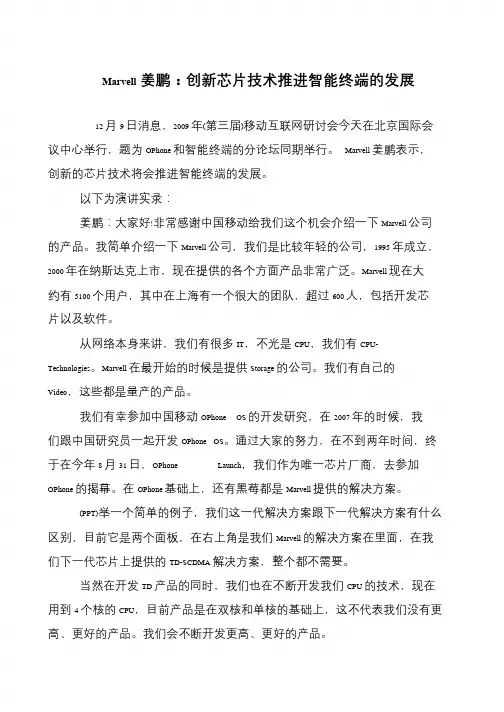
Marvell姜鹏:创新芯片技术推进智能终端的发展12 月9 日消息,2009 年(第三届)移动互联网研讨会今天在北京国际会议中心举行,题为OPhone 和智能终端的分论坛同期举行。
Marvell 姜鹏表示,创新的芯片技术将会推进智能终端的发展。
以下为演讲实录:姜鹏:大家好!非常感谢中国移动给我们这个机会介绍一下Marvell 公司的产品。
我简单介绍一下Marvell 公司,我们是比较年轻的公司,1995 年成立,2000 年在纳斯达克上市,现在提供的各个方面产品非常广泛。
Marvell 现在大约有5100 个用户,其中在上海有一个很大的团队,超过600 人,包括开发芯片以及软件。
从网络本身来讲,我们有很多IT,不光是CPU,我们有CPU- Technologies。
Marvell 在最开始的时候是提供Storage 的公司。
我们有自己的Video,这些都是量产的产品。
我们有幸参加中国移动OPhone OS 的开发研究,在2007 年的时候,我们跟中国研究员一起开发OPhone OS。
通过大家的努力,在不到两年时间,终于在今年8 月31 日,OPhone Launch,我们作为唯一芯片厂商,去参加OPhone 的揭幕。
在OPhone 基础上,还有黑莓都是Marvell 提供的解决方案。
(PPT)举一个简单的例子,我们这一代解决方案跟下一代解决方案有什么区别,目前它是两个面板,在右上角是我们Marvell 的解决方案在里面,在我们下一代芯片上提供的TD-SCDMA 解决方案,整个都不需要。
当然在开发TD 产品的同时,我们也在不断开发我们CPU 的技术,现在用到4 个核的CPU,目前产品是在双核和单核的基础上,这不代表我们没有更高、更好的产品。
我们会不断开发更高、更好的产品。
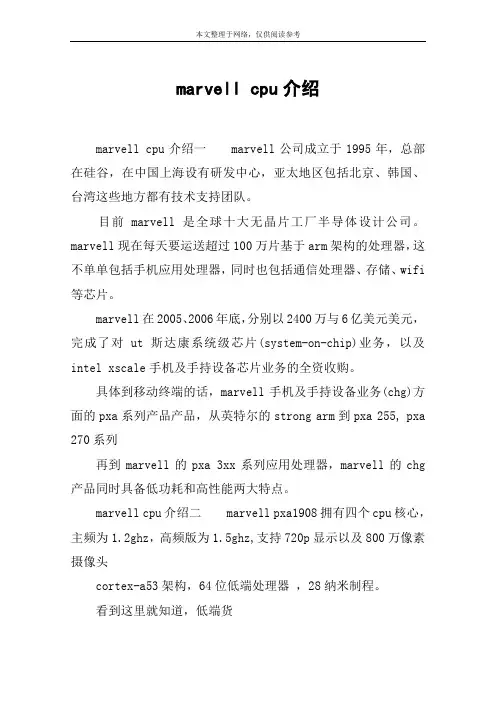
marvell cpu介绍marvell cpu介绍一marvell公司成立于1995年,总部在硅谷,在中国上海设有研发中心,亚太地区包括北京、韩国、台湾这些地方都有技术支持团队。
目前marvell是全球十大无晶片工厂半导体设计公司。
marvell现在每天要运送超过100万片基于arm架构的处理器,这不单单包括手机应用处理器,同时也包括通信处理器、存储、wifi 等芯片。
marvell在2005、2006年底,分别以2400万与6亿美元美元,完成了对ut斯达康系统级芯片(system-on-chip)业务,以及intel xscale手机及手持设备芯片业务的全资收购。
具体到移动终端的话,marvell手机及手持设备业务(chg)方面的pxa系列产品产品,从英特尔的strong arm到pxa 255, pxa 270系列再到marvell的pxa 3xx系列应用处理器,marvell的chg 产品同时具备低功耗和高性能两大特点。
marvell cpu介绍二marvell pxa1908拥有四个cpu核心,主频为1.2ghz,高频版为1.5ghz,支持720p显示以及800万像素摄像头cortex-a53架构,64位低端处理器,28纳米制程。
看到这里就知道,低端货marvell cpu介绍三这两个cpu性能是一样的,cpu部分均为a7架构,主频都是1.2ghz,gpu部分均为gc2000,按理说这cpu性能还是可以的,玩个大游戏什么的不会卡,但是实际用起来由于gpu优化的不好兼容性差一直是公认的,很多主流游戏都无法兼容,所以实际性能还不如mtk6589,但是也这两个cpu也绝对能和普通的a9架构双核有的一拼了至于楼下那位id是neveraspire的傻逼说的话,你就别信了,第一这两个cpu性能完全一模一样,不存在哪个好哪个差的问题,第二gc2000的显卡,性能还是不错的比sgx540都要强,只要能兼容,玩大游戏都不会卡更别说是小游戏,所以那位傻逼说玩小游戏都会卡,真是痴人说梦相关阅读:cpu功能介绍处理指令英文processing instructions;这是指控制程序中指令的执行顺序。
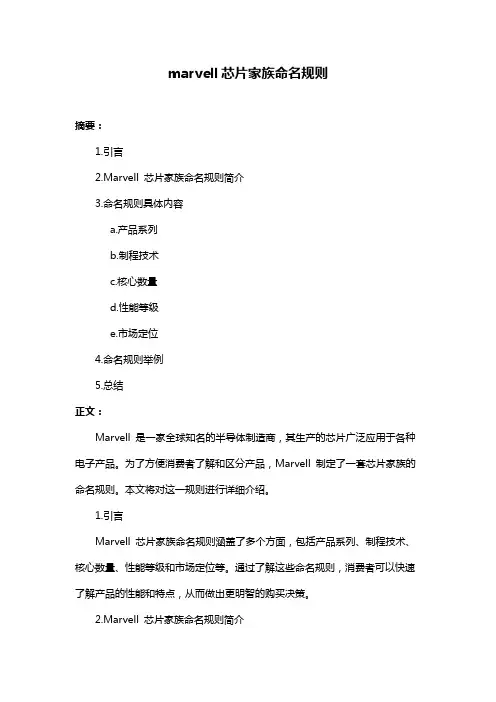
marvell芯片家族命名规则摘要:1.引言2.Marvell 芯片家族命名规则简介3.命名规则具体内容a.产品系列b.制程技术c.核心数量d.性能等级e.市场定位4.命名规则举例5.总结正文:Marvell 是一家全球知名的半导体制造商,其生产的芯片广泛应用于各种电子产品。
为了方便消费者了解和区分产品,Marvell 制定了一套芯片家族的命名规则。
本文将对这一规则进行详细介绍。
1.引言Marvell 芯片家族命名规则涵盖了多个方面,包括产品系列、制程技术、核心数量、性能等级和市场定位等。
通过了解这些命名规则,消费者可以快速了解产品的性能和特点,从而做出更明智的购买决策。
2.Marvell 芯片家族命名规则简介Marvell 芯片的命名规则主要分为几个部分:产品系列、制程技术、核心数量、性能等级和市场定位。
这些信息可以帮助我们快速了解芯片的基本性能和特点。
3.命名规则具体内容a.产品系列:Marvell 的产品系列以数字表示,如88F、8000、88W 等。
不同数字代表不同系列,具有不同的性能特点。
b.制程技术:制程技术以纳米为单位表示,如28nm、16nm 等。
制程技术越先进,功耗和性能表现通常越好。
c.核心数量:核心数量表示处理器内部的核心单元数量,如四核、八核等。
核心数量越多,处理能力越强。
d.性能等级:性能等级通常以字母表示,如A、B、C 等。
字母越靠前,性能等级越高。
e.市场定位:市场定位包括消费级、企业级、工业级等。
不同市场定位的芯片适用于不同的场景和需求。
4.命名规则举例以Marvell 88W8000 为例,我们可以分析其命名规则:- 88:代表产品系列,表示该芯片属于88 系列。
- W:代表市场定位,表示该芯片为消费级产品。
- 8000:代表制程技术,表示该芯片采用28nm 制程技术。
- 最后一位数字省略,表示核心数量为四核。
通过这个例子,我们可以看出Marvell 芯片命名规则的组成和含义。
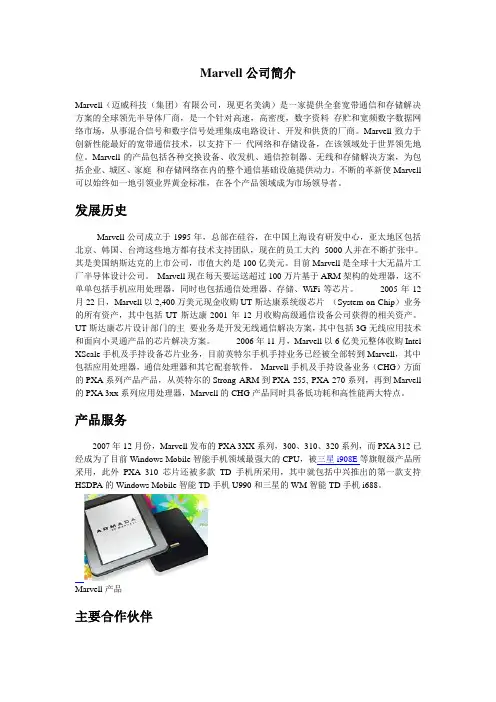
Marvell公司简介Marvell(迈威科技(集团)有限公司,现更名美满)是一家提供全套宽带通信和存储解决方案的全球领先半导体厂商,是一个针对高速,高密度,数字资料存贮和宽频数字数据网络市场,从事混合信号和数字信号处理集成电路设计、开发和供货的厂商。
Marvell致力于创新性能最好的宽带通信技术,以支持下一代网络和存储设备,在该领域处于世界领先地位。
Marvell的产品包括各种交换设备、收发机、通信控制器、无线和存储解决方案,为包括企业、城区、家庭和存储网络在内的整个通信基础设施提供动力。
不断的革新使Marvell 可以始终如一地引领业界黄金标准,在各个产品领域成为市场领导者。
发展历史Marvell公司成立于1995年,总部在硅谷,在中国上海设有研发中心,亚太地区包括北京、韩国、台湾这些地方都有技术支持团队,现在的员工大约5000人并在不断扩张中。
其是美国纳斯达克的上市公司,市值大约是100亿美元。
目前Marvell是全球十大无晶片工厂半导体设计公司。
Marvell现在每天要运送超过100万片基于ARM架构的处理器,这不单单包括手机应用处理器,同时也包括通信处理器、存储、WiFi等芯片。
2005年12月22日,Marvell以2,400万美元现金收购UT斯达康系统级芯片(System-on-Chip)业务的所有资产,其中包括UT斯达康2001年12月收购高级通信设备公司获得的相关资产。
UT斯达康芯片设计部门的主要业务是开发无线通信解决方案,其中包括3G无线应用技术和面向小灵通产品的芯片解决方案。
2006年11月,Marvell以6亿美元整体收购Intel XScale手机及手持设备芯片业务,目前英特尔手机手持业务已经被全部转到Marvell,其中包括应用处理器,通信处理器和其它配套软件。
Marvell手机及手持设备业务(CHG)方面的PXA系列产品产品,从英特尔的Strong ARM到PXA 255, PXA 270系列,再到Marvell 的PXA 3xx系列应用处理器,Marvell的CHG产品同时具备低功耗和高性能两大特点。
国产Wi-Fi芯片厂商及产品盘点瞄准物联网市场
在《六大Wi-Fi芯片厂商主流产品及参数盘点》一文中,小编为大家介绍了Wi-Fi技术以及其特点,并且带来了Broadcom、Marvell、德州仪器等厂商的介绍及产品。
本文将介绍国内wifi厂商以及其推出的针对物联网的芯片。
乐鑫
乐鑫信息科技(上海)有限公司(Espressif Systems (Shanghai)Pte.,Ltd.)总部位于上海张江高科技园区,是无晶圆半导体公司,致力于研发设计Wi-Fi 和蓝牙技术的无线系统级芯片,提供移动通讯和物联网解决方案。
1、ESP8266
标准:802.11 b/g/n
频段:2.4GHz
功能:WiFi+MCU
2、ESP8285标准:802.11 b/g/n
频段:2.4GHz
新岸线
新岸线创建于2004年,总部设立在北京,上海、广州、深圳成立了分公司。
致力于宽带无线通信和智能处理器IC核心技术研发,涉及移动通信、智能终端、智能交通、智慧家居等多个行业领域。
NL6621(T)
标准:802.11/b/g/n
频段:2.4GHz
功能:WiFi+Cortex-M3。
Marvell推出突破性的HyperDuo SATA控制器88SE9230全球集成芯片解决方案的领导厂商美满电子科技(Marvell,纳斯达克代码:MRVL)今日宣布,推出Marvell® 88SE9230 6Gb/s SATA控制器,该控制器基于HyperDuo™嵌入式处理器技术。
新的Marvell 88SE9230解决方案与前一代解决方案相比,性能、容量和可扩展性提高了一倍,从而使消费类台式电脑主板和消费类电子产品充分受益于固态硬盘(SSD)的技术优势。
Marvell的HyperDuo技术实现了像SSD一样的性能,同时允许所有数据存储在传统SATA硬盘(HDD)中。
Marvell最新推出的高级SATA控制器为实现新一代高端消费类应用奠定了基础,有4个端口用于SSD或硬盘连接,容量翻了一番,同时该控制器现在还配备了两个PCIe 2.0通道,可提供增大一倍的PCIe总线带宽,以容纳多个SATA SSD。
88SE9230 SATA控制器采用智能算法,以自动从引脚输出多达3个SATA SSD的热门数据文件和目录,同时使所有数据都能安全地存储在容量更大的SATA硬盘中。
88SE9230还可提供无与伦比的安全性,包括128/256位实时AES加密,以确保实现最高的数据安全性。
Marvell产品市场总监Shawn Kung表示:“Marvell致力于通过闻名于世的高性能、低成本和低功耗芯片解决方案,向主流消费类技术市场提供领先的自动化和集成式SSD加速技术,这是Marvell一直以来的使命。
我们在SATA技术产品领域拥有领先地位,今天推出的具有里程碑意义的88SE9230以及我们为重要客户提供的专门支持,再次肯定了这一点。
” Marvell SATA 6Gb/s控制器基于HyperDuo技术,为主流消费类技术市场提供了集成式SSD 加速技术,尤其是高端台式电脑和笔记本电脑、家用NAS和机顶盒以及主机总线适配器市场。
Marvell芯片家族命名规则1. 引言Marvell是一家全球领先的半导体公司,专注于设计和开发各种高性能芯片。
为了方便管理和区分不同的产品系列,Marvell制定了一套严格的芯片家族命名规则。
本文将详细介绍Marvell芯片家族命名规则的背景、要求和实施方式。
2. 背景在半导体行业中,产品众多且涉及的领域广泛。
为了避免混淆和误解,各个芯片家族需要有独特的命名规则。
Marvell作为一家拥有多个产品系列的半导体公司,也面临着这个问题。
因此,Marvell制定了一套统一的芯片家族命名规则,以便于公司内外的人员理解和识别。
3. 要求Marvell芯片家族命名规则需要满足以下要求:3.1 独特性每个芯片家族的命名必须是独一无二的,不能与其他芯片家族重复。
3.2 信息性芯片家族的命名应能够传达关于该系列芯片的基本信息,如应用领域、性能特点等。
3.3 简洁性命名应尽量简洁明了,易于记忆和使用。
3.4 规范性命名规则应严格遵守公司内部规定,确保统一性和一致性。
4. 实施方式为了满足上述要求,Marvell制定了一套详细的芯片家族命名规则。
下面将详细介绍Marvell芯片家族命名规则的实施方式。
4.1 命名前缀每个芯片家族的命名都以一个特定的前缀开头,该前缀与芯片家族的特性相关。
例如,以”M”开头的前缀表示高性能多核处理器,以”E”开头的前缀表示低功耗嵌入式处理器等。
4.2 命名主体命名主体是芯片家族的核心部分,用于传达关于该系列芯片的基本信息。
通常包括数字、字母和特殊符号的组合,以表达芯片的特性和用途。
例如,“88”表示高性能、“X”表示嵌入式、“G”表示网络等。
4.3 命名后缀命名后缀用于进一步区分同一系列中的不同产品。
通常是一个字母或数字的组合,表示不同的版本或配置。
例如,“A”表示第一版、“B”表示第二版等。
5. 示例下面是几个根据Marvell芯片家族命名规则命名的示例:5.1 M88X“M88X”是一个高性能多核处理器系列的命名。
Marvell新款交换机支持节能以太网美满电子科技(Marvell)发布三款Link Street®以太网系列新品,为低成本、能耗敏感的应用提供了快速以太网和千兆以太网解决方案。
Marvell® 88E6352、88E6250和88E62 20均集成了物理层(PHY)芯片,支持802.3az节能以太网(Energy Efficient Ethernet,EEE)标准,以及其他多个先进的功能,包括局域网唤醒(Wake-on-LAN,WoL)、集成的开机热启动(Power-On Reset)控制器和电源监视器。
此外,新设备还支持IEEE 802.1新的语音视频桥接(AVB)标准,可以无缝交付延时敏感的多媒体流量,在容易配置的以太网中实现消费级和专业级的语音视频应用。
它们还支持IEE E 1588v2 PTP精确时钟协议(Precision Time Protocol)标准,实现以太网上节点之间1毫秒以内的时钟同步。
这一新的系列产品主要面向包括无线路由器、网关和企业网络接入在内的公共云和私有云接入市场,为它们提供高成本效率和能源效率解决方案,同时扩展以太网的能力,满足云内部应用中以媒体为中心的应用需求,例如:机顶盒、数字录像机、音频/视频接收器等等。
产品亮点88E6352● 7端口千兆以太网交换机,具有5个集成的三速PHY、GMII、RGMII和Serdes/SGMII接口● 集成的PHY,支持802.3az节能以太网(Energy Efficient Ethernet),当网络空闲时可以降低能耗70%以上● 支持最新的AVB标准● 256个条目TCAM,提供多达96字节深度的包检测● 支持IEEE 1588v2工业以太网应用● 低成本128引脚QFP(14x14毫米)封装88E6250和88E6220● 88E6250是一个7端口的快速以太网交换机,具有5个有集成的快速以太网 PHY和两个RMII(或一个MII/RGMII)接口● 88E6220是一个4端口的快速以太网交换机,具有2个有集成的快速以太网PHY和两个M II/RMII接口● 集成的PHY,支持802.3az节能以太网(Energy Efficient Ethernet),当网络空闲时可以降低能耗50%以上● 支持最新的AVB标准● 支持IEEE 1588v2工业以太网应用● 64引脚QFN(9x9毫米)封装,是当前市场上体积最小的7端口快速以太网交换机Marvell 率先推出40纳米8端口千兆以太网收发器美满电子科技(MARVELL)日前宣布推出MARVELL Alaska V系列产品,这是业界首个采用40纳米工艺的超低功耗、八端口、高能效的千兆以太网收发器。
ThinkSystem Marvell QL41132 and QL4113410GBASE-T Ethernet AdaptersProduct GuideThe QL41134 4-Port and QL41132 2-Port 10GBASE-T Ethernet Adapters are an advanced 10 Gb Ethernet adapters from Marvell which feature Universal Remote Direct Memory Access (RDMA) to offer concurrent support for RoCE, RoCE v2, and iWARP. The adapters are suitable for customers wishing to use advanced technologies while still maintaining their investment in RJ45 copper wiring.The following figure shows the ThinkSystem QLogic QL41134 PCIe 10Gb 4-Port Base-T Ethernet Adapter.Figure 1. ThinkSystem QLogic QL41134 PCIe 10Gb 4-Port Base-T Ethernet AdapterDid you know?10GBASE-T is a low-cost way to enter the 10 Gb Ethernet space. By using standard UTP twisted pair cabling, you eliminate the need for transceivers or fiber optic cabling.Universal RDMA is the term used in Marvell and QLogic adapters that support RoCE, RoCEv2, and iWARP. Such support enables easy migration from one technology to another, since each port can operate a different RDMA protocol at the same time.Click here to check for updatesFigure 2. ThinkSystem Marvell QL41132 10GBASE-T 2-port OCP Ethernet Adapter Network cabling requirementsThe network cables that can be used with the adapters are as follows: 10GBASE-TUTP Category 7 (100 m maximum)UTP Category 6a (100 m maximum)UTP Category 6 (55 m maximum)1000BASE-TUTP Category 7 (100 m maximum)UTP Category 6a (100 m maximum)UTP Category 6 (100 m maximum)UTP Category 5e (100 m maximum)The following table lists the supported Category 6 (CAT 6) cables.Part number Feature code DescriptionCAT6 Green Cables00WE123AVFW0.75m Green Cat6 Cable00WE127AVFX 1.0m Green Cat6 Cable00WE131AVFY 1.25m Green Cat6 Cable00WE135AVFZ 1.5m Green Cat6 Cable00WE139AVG03m Green Cat6 Cable90Y3718A1MT10m Green Cat6 Cable90Y3727A1MW25m Green Cat6 CableCAT6 Blue Cables90Y3721A1MU10m Blue Cat6 Cable90Y3730A1MX25m Blue Cat6 CableCAT6 Yellow Cables90Y3715A1MS10m Yellow Cat6 Cable90Y3724A1MV25m Yellow Cat6 CableThe following table lists the supported Category 5e (CAT 5e) cables. These cables are not supported at 10Gb speeds.Part number Feature code DescriptionCAT5e Blue Cables40K567938010.6m Blue Cat5e Cable 00WE111AVFT0.75m Blue Cat5e Cable 00WE115AVFU 1.0m Blue Cat5e Cable 00WE119AVFV 1.25m Blue Cat5e Cable 40K87853802 1.5m Blue Cat5e Cable 40K558138033m Blue Cat5e Cable40K8927380410m Blue Cat5e Cable40K8930380525m Blue Cat5e Cable CAT5e Green Cables40K556337960.6m Green Cat5e Cable 00WE099AVFQ0.75m Green Cat5e Cable 00WE103AVFR 1.0m Green Cat5e Cable 00WE107AVFS 1.25m Green Cat5e Cable 40K56433797 1.5m Green Cat5e Cable 40K579337983m Green Cat5e Cable 40K5794379910m Green Cat5e Cable 40K8869380025m Green Cat5e Cable CAT5e Yellow Cables40K893337910.6m Yellow Cat5e Cable 40K89513792 1.5m Yellow Cat5e Cable 40K895737933m Yellow Cat5e Cable 40K8801379410m Yellow Cat5e Cable 40K8807379525m Yellow Cat5e CableMicrosoft Windows Server 2019Y Y Y Y Y Y Y Y Y Y Microsoft Windows Server version 1709N N N N N N N N N N Microsoft Windows Server version 1803N N N N N N N N N N Red Hat Enterprise Linux 6.10N N N N N N N N N N Red Hat Enterprise Linux 6.9N N N N N N N N N N Red Hat Enterprise Linux 7.4N N N N N N N N N N Red Hat Enterprise Linux 7.5Y Y N N N NNNN N Red Hat Enterprise Linux 7.6N N N N N N Y Y Y Y Red Hat Enterprise Linux 7.7Y Y N N N N Y Y Y Y Red Hat Enterprise Linux 7.8Y Y N N N N Y Y Y Y Red Hat Enterprise Linux 7.9Y Y Y Y Y Y Y Y Y Y Red Hat Enterprise Linux 8.0Y Y N N N N Y NY NRed Hat Enterprise Linux 8.1Y Y N N N N Y Y Y Y Red Hat Enterprise Linux 8.2Y Y Y Y Y Y Y Y Y Y Red Hat Enterprise Linux 8.3Y Y Y Y Y Y Y Y Y Y Red Hat Enterprise Linux 8.4Y Y Y Y Y Y Y Y Y Y Red Hat Enterprise Linux 8.5Y Y Y Y Y Y Y Y Y Y Red Hat Enterprise Linux 8.6Y Y Y Y Y Y Y Y Y Y Red Hat Enterprise Linux 8.7Y Y Y Y Y Y Y Y Y Y Red Hat Enterprise Linux 8.8Y Y Y Y Y Y Y Y Y Y Red Hat Enterprise Linux 8.9Y Y Y Y Y Y Y Y Y Y SUSE Linux Enterprise Server 11 SP4N N N N N N N N N N SUSE Linux Enterprise Server 11 SP4 with Xen N N N N N N N N N N SUSE Linux Enterprise Server 12 SP3Y Y N N N N N N N N SUSE Linux Enterprise Server 12 SP3 with Xen Y Y N N N NNN N N SUSE Linux Enterprise Server 12 SP4N N N N N N Y N Y N SUSE Linux Enterprise Server 12 SP4 with Xen N N N N N N Y N Y N SUSE Linux Enterprise Server 12 SP5Y Y Y Y Y Y Y Y Y Y SUSE Linux Enterprise Server 12 SP5 with Xen Y Y Y Y Y Y Y Y Y Y SUSE Linux Enterprise Server 15Y Y N N N NNNN NSUSE Linux Enterprise Server 15 SP1Y Y N N N N Y Y Y Y SUSE Linux Enterprise Server 15 SP1 with Xen Y Y N N N N Y Y Y Y SUSE Linux Enterprise Server 15 SP2Y Y Y Y Y Y Y Y Y Y SUSE Linux Enterprise Server 15 SP2 with Xen Y Y Y Y Y Y Y Y Y Y SUSE Linux Enterprise Server 15 SP3Y Y Y Y Y Y Y Y Y Y SUSE Linux Enterprise Server 15 SP3 with Xen Y Y Y Y Y Y Y Y Y Y SUSE Linux Enterprise Server 15 SP4Y Y Y Y Y Y Y Y Y Y SUSE Linux Enterprise Server 15 SP4 with Xen Y Y Y Y Y Y Y Y Y Y SUSE Linux Enterprise Server 15 with XenY Y N N N NNNNNOperating systemsS R 150S R 250S R 630 V 2S R 650 V 2S R 850 V 2S R 860 V 2S R 635S R 645S R 655S R 66511111111111111111111111111111111111111Ubuntu 18.04.5 LTS N N Y Y N N N N N N Ubuntu 20.04 LTSN N Y Y N N N N N N VMware vSphere Hypervisor (ESXi) 6.0 U3N N N N N N N N N N VMware vSphere Hypervisor (ESXi) 6.5N N N N N N N N N N VMware vSphere Hypervisor (ESXi) 6.5 U1N N N N N N N N N N VMware vSphere Hypervisor (ESXi) 6.5 U2Y Y N N N N N N N N VMware vSphere Hypervisor (ESXi) 6.5 U3Y Y N N N N Y N Y N VMware vSphere Hypervisor (ESXi) 6.7Y Y N N N N N N N N VMware vSphere Hypervisor (ESXi) 6.7 U1N N N N N N N N N N VMware vSphere Hypervisor (ESXi) 6.7 U2Y Y N N N N N N N N VMware vSphere Hypervisor (ESXi) 6.7 U3Y Y Y Y N NYY Y YVMware vSphere Hypervisor (ESXi) 7.0Y Y N N N N Y Y Y Y VMware vSphere Hypervisor (ESXi) 7.0 U1Y Y N N Y Y Y Y Y Y VMware vSphere Hypervisor (ESXi) 7.0 U2Y Y Y Y Y Y Y Y Y Y VMware vSphere Hypervisor (ESXi) 7.0 U3Y Y Y Y Y YYYYYOperating systems The OS is not supported with EPYC 7003 processors.Table 8. Operating system support for ThinkSystem QLogic QL41134 PCIe 10Gb 4-Port Base-T Ethernet Adapter, 4XC7A08225 (Part 2 of 3)Operating systemsMicrosoft Windows Server 2012 R2N N N N N N N N N N N N Microsoft Windows Server 2016Y Y Y Y Y Y Y Y Y Y Y Y Microsoft Windows Server 2019Y Y Y Y Y Y Y Y Y Y Y Y Microsoft Windows Server version 1709N N N N N N N N N N N N Microsoft Windows Server version 1803N N N N N N N N N N N N Red Hat Enterprise Linux 6.10N N N N N N N N N N N N Red Hat Enterprise Linux 6.9N N N N N N N N N N N N Red Hat Enterprise Linux 7.4N N N N N N N N N N N N Red Hat Enterprise Linux 7.5N N N N N N N N N N N N Red Hat Enterprise Linux 7.6Y Y Y Y Y Y Y Y Y Y Y Y Red Hat Enterprise Linux 7.7Y Y Y Y Y Y Y Y Y Y Y Y Red Hat Enterprise Linux 7.8Y Y Y Y Y Y Y Y Y Y Y Y Red Hat Enterprise Linux 7.9Y Y Y Y Y Y Y Y Y Y Y YS R 150S R 250S R 630 V 2S R 650 V 2S R 850 V 2S R 860 V 2S R 635S R 645S R 655S R 665111111111S D 530 (X e o n G e n 2)S R 530 (X e o n G e n 2)S R 550 (X e o n G e n 2)S R 570 (X e o n G e n 2)S R 590 (X e o n G e n 2)S R 630 (X e o n G e n 2)S R 650 (X e o n G e n 2)S R 850 (X e o n G e n 2)S R 850P (X e o n G e n 2)S R 860 (X e o n G e n 2)S R 950 (X e o n G e n 2)S T 550 (X e o n G e n 2)Red Hat Enterprise Linux 8.0Y Y Y Y Y Y Y Y Y Y Y Y Red Hat Enterprise Linux 8.1Y Y Y Y Y Y Y Y Y Y Y Y Red Hat Enterprise Linux 8.2Y Y Y Y Y Y Y Y Y Y Y Y Red Hat Enterprise Linux 8.3Y Y Y Y Y Y Y Y Y Y Y Y Red Hat Enterprise Linux 8.4Y Y Y Y Y Y Y Y Y Y Y Y Red Hat Enterprise Linux 8.5Y Y Y Y Y Y Y Y Y Y Y Y Red Hat Enterprise Linux 8.6Y Y Y Y Y Y Y Y Y Y Y Y Red Hat Enterprise Linux 8.7Y Y Y Y Y Y Y Y Y Y Y Y Red Hat Enterprise Linux 8.8Y Y Y Y Y Y Y Y Y Y Y Y Red Hat Enterprise Linux 8.9Y Y Y Y Y Y Y Y Y Y Y Y SUSE Linux Enterprise Server 11 SP4N N N N N N N N N N N N SUSE Linux Enterprise Server 11 SP4 with Xen N N N N N N N N N N N N SUSE Linux Enterprise Server 12 SP3N N N N N N N N Y N N N SUSE Linux Enterprise Server 12 SP3 with Xen N N N N N N N N Y N N N SUSE Linux Enterprise Server 12 SP4Y Y Y Y Y Y Y Y Y Y Y Y SUSE Linux Enterprise Server 12 SP4 with Xen Y Y Y Y Y Y Y Y Y Y Y Y SUSE Linux Enterprise Server 12 SP5Y Y Y Y Y Y Y Y Y Y Y Y SUSE Linux Enterprise Server 12 SP5 with Xen Y Y Y Y Y Y Y Y Y Y Y Y SUSE Linux Enterprise Server 15Y Y Y Y Y Y Y Y Y Y Y Y SUSE Linux Enterprise Server 15 SP1Y Y Y Y Y Y Y Y Y Y Y Y SUSE Linux Enterprise Server 15 SP1 with Xen Y Y Y Y Y Y Y Y Y Y Y Y SUSE Linux Enterprise Server 15 SP2Y Y Y Y Y Y Y Y Y Y Y Y SUSE Linux Enterprise Server 15 SP2 with Xen Y Y Y Y Y Y Y Y Y Y Y Y SUSE Linux Enterprise Server 15 SP3Y Y Y Y Y Y Y Y Y Y Y Y SUSE Linux Enterprise Server 15 SP3 with Xen Y Y Y Y Y Y Y Y Y Y Y Y SUSE Linux Enterprise Server 15 SP4Y Y Y Y Y Y Y Y Y Y Y Y SUSE Linux Enterprise Server 15 SP4 with Xen Y Y Y Y Y Y Y Y Y Y Y Y SUSE Linux Enterprise Server 15 with Xen Y Y Y Y Y Y Y Y Y Y Y Y Ubuntu 18.04.5 LTS N N N N N N N N N N N N Ubuntu 20.04 LTSN N N N N N N N N N N N VMware vSphere Hypervisor (ESXi) 6.0 U3N N N N N N N N N N N N VMware vSphere Hypervisor (ESXi) 6.5N N N N N N N N N N N N VMware vSphere Hypervisor (ESXi) 6.5 U1N N N N N N N N N N N N VMware vSphere Hypervisor (ESXi) 6.5 U2Y Y Y Y Y Y Y Y Y Y Y Y VMware vSphere Hypervisor (ESXi) 6.5 U3Y Y Y Y Y Y Y Y Y Y Y YOperating systems S D 530 (X e o n G e n 2)S R 530 (X e o n G e n 2)S R 550 (X e o n G e n 2)S R 570 (X e o n G e n 2)S R 590 (X e o n G e n 2)S R 630 (X e o n G e n 2)S R 650 (X e o n G e n 2)S R 850 (X e o n G e n 2)S R 850P (X e o n G e n S R 860 (X e o n G e n 2)S R 950 (X e o n G e n 2)S T 550 (X e o n G e n 2)VMware vSphere Hypervisor (ESXi) 6.7N N N N N N N N N N N N VMware vSphere Hypervisor (ESXi) 6.7 U1Y Y Y Y Y Y Y Y Y Y Y Y VMware vSphere Hypervisor (ESXi) 6.7 U2Y Y Y Y Y Y Y Y Y Y Y Y VMware vSphere Hypervisor (ESXi) 6.7 U3Y Y Y Y Y Y Y Y Y Y Y Y VMware vSphere Hypervisor (ESXi) 7.0Y Y Y Y Y Y Y Y Y Y Y Y VMware vSphere Hypervisor (ESXi) 7.0 U1Y Y Y Y Y Y Y Y Y Y Y Y VMware vSphere Hypervisor (ESXi) 7.0 U2Y Y Y Y Y Y Y Y Y Y Y Y VMware vSphere Hypervisor (ESXi) 7.0 U3Y Y Y Y Y Y Y Y Y Y Y YOperating systemsTable 9. Operating system support for ThinkSystem QLogic QL41134 PCIe 10Gb 4-Port Base-T Ethernet Adapter, 4XC7A08225 (Part 3 of 3)Operating systemsMicrosoft Windows Server 2012 R2Y Y Y Y Y Y Y Y Y Y Y Microsoft Windows Server 2016Y Y Y Y Y Y Y Y Y Y Y Microsoft Windows Server 2019Y Y Y Y Y Y Y Y Y Y Y Microsoft Windows Server version 1709Y Y Y Y Y Y Y Y Y Y Y Microsoft Windows Server version 1803Y N N N N Y Y Y Y Y N Red Hat Enterprise Linux 6.10Y Y Y Y Y Y Y Y Y Y Y Red Hat Enterprise Linux 6.9Y Y Y Y Y Y Y Y Y Y Y Red Hat Enterprise Linux 7.4Y Y Y Y Y Y Y Y Y Y Y Red Hat Enterprise Linux 7.5Y Y Y Y Y Y Y Y Y Y Y Red Hat Enterprise Linux 7.6Y Y Y Y Y Y Y Y Y Y Y Red Hat Enterprise Linux 7.7Y Y Y Y Y Y Y Y Y Y Y Red Hat Enterprise Linux 7.8Y Y Y Y Y Y Y Y Y Y Y Red Hat Enterprise Linux 7.9Y Y Y Y Y Y Y Y Y Y Y Red Hat Enterprise Linux 8.0Y Y Y Y Y Y Y Y Y Y Y Red Hat Enterprise Linux 8.1Y Y Y Y Y Y Y Y Y Y Y Red Hat Enterprise Linux 8.2Y Y Y Y Y Y Y Y Y Y Y Red Hat Enterprise Linux 8.3Y Y Y Y Y Y Y Y Y Y Y Red Hat Enterprise Linux 8.4Y Y Y Y Y Y Y Y Y Y Y Red Hat Enterprise Linux 8.5Y Y Y Y Y Y Y Y Y Y YS D 530 (X e o n G e n 2)S R 530 (X e o n G e n 2)S R 550 (X e o n G e n 2)S R 570 (X e o n G e n 2)S R 590 (X e o n G e n 2)S R 630 (X e o n G e n 2)S R 650 (X e o n G e n 2)S R 850 (X e o n G e n 2)S R 850P (X e o n G e n S R 860 (X e o n G e n 2)S R 950 (X e o n G e n 2)S T 550 (X e o n G e n 2)S D 530 (X e o n G e n 1)S R 530 (X e o n G e n 1)S R 550 (X e o n G e n 1)S R 570 (X e o n G e n 1)S R 590 (X e o n G e n 1)S R 630 (X e o n G e n 1)S R 650 (X e o n G e n 1)S R 850 (X e o n G e n 1)S R 860 (X e o n G e n 1)S R 950 (X e o n G e n 1)S T 550 (X e o n G e n 1)Red Hat Enterprise Linux 8.6Y Y Y Y Y Y Y Y Y Y Y Red Hat Enterprise Linux 8.7Y Y Y Y Y Y Y Y Y Y Y Red Hat Enterprise Linux 8.8Y Y Y Y Y Y Y Y Y Y Y Red Hat Enterprise Linux 8.9N N N N N N N N N N N SUSE Linux Enterprise Server 11 SP4Y Y N Y Y Y Y Y Y Y Y SUSE Linux Enterprise Server 11 SP4 with Xen Y Y N Y Y Y Y Y Y Y Y SUSE Linux Enterprise Server 12 SP3Y Y Y Y Y Y Y Y Y Y Y SUSE Linux Enterprise Server 12 SP3 with Xen Y Y Y Y Y Y Y Y Y Y Y SUSE Linux Enterprise Server 12 SP4Y Y Y Y Y Y Y Y Y Y Y SUSE Linux Enterprise Server 12 SP4 with Xen Y Y Y Y Y Y Y Y Y Y Y SUSE Linux Enterprise Server 12 SP5Y Y Y Y Y Y Y Y Y Y Y SUSE Linux Enterprise Server 12 SP5 with Xen Y Y Y Y Y Y Y Y Y Y Y SUSE Linux Enterprise Server 15Y Y Y Y Y Y Y Y Y Y Y SUSE Linux Enterprise Server 15 SP1Y Y Y Y Y Y Y Y Y Y Y SUSE Linux Enterprise Server 15 SP1 with Xen Y Y Y Y Y Y Y Y Y Y Y SUSE Linux Enterprise Server 15 SP2Y Y Y Y Y Y Y Y Y Y Y SUSE Linux Enterprise Server 15 SP2 with Xen Y Y Y Y Y Y Y Y Y Y Y SUSE Linux Enterprise Server 15 SP3Y Y Y Y Y Y Y Y Y Y Y SUSE Linux Enterprise Server 15 SP3 with Xen Y Y Y Y Y Y Y Y Y Y Y SUSE Linux Enterprise Server 15 SP4Y Y Y Y Y Y Y Y Y Y Y SUSE Linux Enterprise Server 15 SP4 with Xen Y Y Y Y Y Y Y Y Y Y Y SUSE Linux Enterprise Server 15 with Xen Y Y Y Y Y Y Y Y Y Y Y Ubuntu 18.04.5 LTS N N N N N N N N N N N Ubuntu 20.04 LTSN N N N N N N N N N N VMware vSphere Hypervisor (ESXi) 6.0 U3Y Y N Y Y Y Y Y Y Y Y VMware vSphere Hypervisor (ESXi) 6.5N N N N N N Y N N N N VMware vSphere Hypervisor (ESXi) 6.5 U1Y Y Y Y Y Y Y Y Y Y Y VMware vSphere Hypervisor (ESXi) 6.5 U2Y Y Y Y Y Y Y Y Y Y Y VMware vSphere Hypervisor (ESXi) 6.5 U3Y Y Y Y Y Y Y Y Y Y Y VMware vSphere Hypervisor (ESXi) 6.7Y Y Y Y Y Y Y Y Y Y Y VMware vSphere Hypervisor (ESXi) 6.7 U1Y Y Y Y Y Y Y Y Y Y Y VMware vSphere Hypervisor (ESXi) 6.7 U2Y Y Y Y Y Y Y Y Y Y Y VMware vSphere Hypervisor (ESXi) 6.7 U3Y Y Y Y Y Y Y Y Y Y Y VMware vSphere Hypervisor (ESXi) 7.0Y Y Y Y Y Y Y Y Y Y Y VMware vSphere Hypervisor (ESXi) 7.0 U1Y Y Y Y Y Y Y Y Y Y YOperating systems S D 530 (X e o n G e n S R 530 (X e o n G e n S R 550 (X e o n G e n S R 570 (X e o n G e n S R 590 (X e o n G e n S R 630 (X e o n G e n S R 650 (X e o n G e n S R 850 (X e o n G e n S R 860 (X e o n G e n S R 950 (X e o n G e n S T 550 (X e o n G e nVMware vSphere Hypervisor (ESXi) 7.0 U2Y Y Y Y Y Y Y Y Y Y YVMware vSphere Hypervisor (ESXi) 7.0 U3Y Y Y Y Y Y Y Y Y Y Y Operating systemsS D 530 (X e o n G e n S R 530 (X e o n G e n S R 550 (X e o n G e n S R 570 (X e o n G e n S R 590 (X e o n G e n S R 630 (X e o n G e n S R 650 (X e o n G e n S R 850 (X e o n G e n S R 860 (X e o n G e n S R 950 (X e o n G e n S T 550 (X e o n G e nTable 10. Operating system support for ThinkSystem Marvell QL41132 10GBASE-T 2-port OCP Ethernet Adapter, 4XC7A08310Operating systemsMicrosoft Windows Server 2016Y Y Y Y Y Y Y Y Microsoft Windows Server 2019Y Y Y YYYY Y Red Hat Enterprise Linux 7.6N N N N Y Y Y Y Red Hat Enterprise Linux 7.7N N N N Y Y Y Y Red Hat Enterprise Linux 7.8N N N N Y Y Y Y Red Hat Enterprise Linux 7.9Y Y Y Y Y Y Y Y Red Hat Enterprise Linux 8.0N N N N Y NY NRed Hat Enterprise Linux 8.1N N N N Y Y Y Y Red Hat Enterprise Linux 8.2Y Y Y Y Y Y Y Y Red Hat Enterprise Linux 8.3Y Y Y Y Y Y Y Y Red Hat Enterprise Linux 8.4Y Y Y Y Y Y Y Y Red Hat Enterprise Linux 8.5Y Y Y Y Y Y Y Y Red Hat Enterprise Linux 8.6Y Y Y Y Y Y Y Y Red Hat Enterprise Linux 8.7Y Y Y Y Y Y Y Y Red Hat Enterprise Linux 8.8Y Y Y Y Y Y Y Y Red Hat Enterprise Linux 8.9Y Y Y YYY Y Y SUSE Linux Enterprise Server 12 SP4N N N N Y N Y N SUSE Linux Enterprise Server 12 SP4 with Xen N N N N Y N Y N SUSE Linux Enterprise Server 12 SP5Y Y Y Y Y Y Y Y SUSE Linux Enterprise Server 12 SP5 with Xen Y Y Y YYYY YSUSE Linux Enterprise Server 15 SP1N N N N Y Y Y Y SUSE Linux Enterprise Server 15 SP1 with Xen N N N N Y Y Y Y SUSE Linux Enterprise Server 15 SP2Y Y Y Y Y Y Y Y SUSE Linux Enterprise Server 15 SP2 with Xen Y Y Y Y Y Y Y Y SUSE Linux Enterprise Server 15 SP3Y Y Y Y Y Y Y Y SUSE Linux Enterprise Server 15 SP3 with Xen Y Y Y Y Y Y Y Y SUSE Linux Enterprise Server 15 SP4Y Y Y Y Y Y Y Y SUSE Linux Enterprise Server 15 SP4 with Xen Y Y Y Y Y Y Y Y Ubuntu 18.04.5 LTS Y Y N N N N N N Ubuntu 20.04 LTSY Y N N N N N N VMware vSphere Hypervisor (ESXi) 6.5 U3N N N N Y N Y N VMware vSphere Hypervisor (ESXi) 6.7 U3Y Y N NNN N N VMware vSphere Hypervisor (ESXi) 7.0N N N N Y Y Y Y VMware vSphere Hypervisor (ESXi) 7.0 U1N N Y Y Y Y Y Y VMware vSphere Hypervisor (ESXi) 7.0 U2Y Y Y Y Y Y Y Y VMware vSphere Hypervisor (ESXi) 7.0 U3Y Y Y YYYYYS R 630 V 2S R 650 V 2S R 850 V 2S R 860 V 2S R 635S R 645S R 655S R 66511111111111111111111111111111111111111111111111TrademarksLenovo and the Lenovo logo are trademarks or registered trademarks of Lenovo in the United States, other countries, or both. A current list of Lenovo trademarks is available on the Web athttps:///us/en/legal/copytrade/.The following terms are trademarks of Lenovo in the United States, other countries, or both:Lenovo®RackSwitchServerProven®ThinkSystem®XClarity®The following terms are trademarks of other companies:Intel® and Xeon® are trademarks of Intel Corporation or its subsidiaries.Linux® is the trademark of Linus Torvalds in the U.S. and other countries.Microsoft®, Hyper-V®, PowerShell, Windows PowerShell®, Windows Server®, and Windows® are trademarks of Microsoft Corporation in the United States, other countries, or both.Other company, product, or service names may be trademarks or service marks of others.。